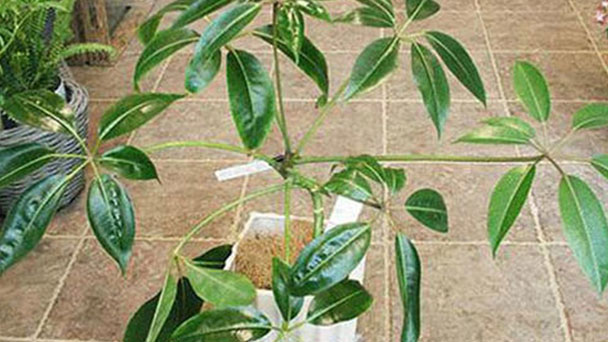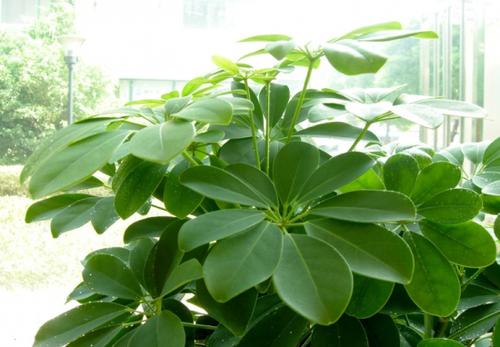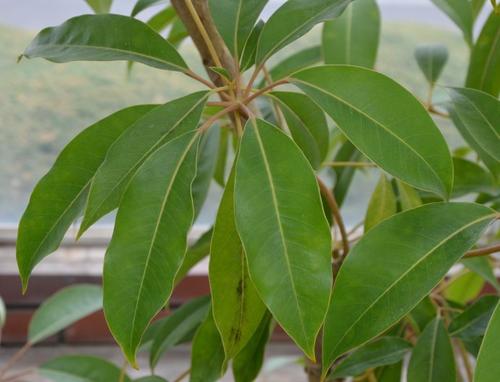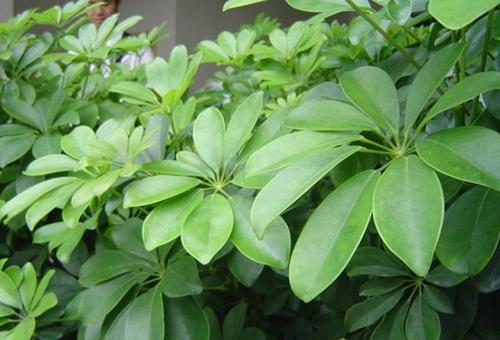Tupidanthus Calyptratus Profile
Written by Maggie
Oct 19 2021

Tupidanthus calyptratus is a large vine of the family Schefflera. At first, it is an erect shrub or small tree, and then branches and climbs to become a large vine. The stem is 15-30 m long and the bark is yellowish brown. Petiole is glabrous; Stipules and petiole base are connate, shortly sheathlike; Leaf blade is leathery, obovate-oblong to oblong, base broadly cuneate to suborbicular, both surfaces glabrous, margin entire, lateral veins conspicuous; Petiole of Tupidanthus calyptratus is glabrous. Umbel with 3-7 flowers, 3-5 in terminal complex umbel or short panicle; Pedicels are stout, glabrous; Bracts are ovate, leathery; Pedicels are stout, glabrous; Flowers are large; Calyx tube of Tupidanthus calyptratus is leathery, glabrous, margin with inconspicuous denticules; Petals are connate into a cap, caducous; Stamens are usually 50-70; Filaments are thick, ovary many locules, indefinite; Style is absent, stigma numerous; Disk of Schefflera pueckleri is broad and flat, centre sunk. Fruit is spherical, dorsal flat, exocarp fleshy.
Tupidanthus calyptratus is distributed in southern Yunnan. It is found in forests, clinging to other trees, about 1600 m above sea level. India, Bangladesh, Myanmar, Vietnam, Laos, Cambodia are also distributed. Multi - stamen wood stems and leaves are for medicinal treatment of injuries, rheumatic bone pain.
Tupidanthus Calyptratus Picture

Tupidanthus Calyptratus Info
| Botanical Name | Tupidanthus calyptratus |
| Common Names | Tupidanthus calyptratus |
| Plant Type | Araliaceae |
| Sun | Partial Shade |
| Foliage color | Evergreen |
| Soil | Moist Soil |
| Native Range | Australia, New Guinea and Java |
| Mature size | 15 - 20 feet high, 15 - 25 feet wide |
Tupidanthus Calyptratus Characteristics
Tupidanthus Calyptratus Branch
Tupidanthus calyptratus is a large vine, which is initially an erect shrub or small tree, and then branches and climbs into a large vine. Stems are 15-30 m long, ca. 15 cm in diameter at base, yellow-brown bark.
Tupidanthus Calyptratus Leaf
Leaves of Tupidanthus calyptratus have lobules 7-9; Petiole is 15-60 cm long, glabrous; Stipules and petiole base are connate, shortly sheathlike; Leaf blade is leathery, obovate-oblong to oblong, 12 -- 26 cm long, 4 -- 9 cm wide, apex short acuminate, base broadly cuneate to suborbicular, both surfaces glabrous, margin entire, lateral veins 20 -- 30 pairs, connate at margin, conspicuous; Petiole of Schefflera pueckleri is 3-5 cm long, glabrous.
Tupidanthus Calyptratus Flowers
Tupidanthus calyptratus is an umbel 4 -- 6 cm in diameter, with 3 -- 7 flowers and 3 -- 5 terminal umbels or short panicles; Pedicels are stout, 4-8 cm long, glabrous; Bracts are ovate, leathery, ca. 1.5 cm long; Pedicels are stout, 1.5-2 cm long, glabrous; Flowers are large, 1.5-2.5 cm in diameter; Calyx tube of tupidanthus calyptratus is leathery, glabrous, margin with inconspicuous denticules; Petals connate into a cap, caducous; Stamens are numerous, usually 50-70; Filaments are thick, ca. 3 mm long, ovary many locules, indeterminate; Styles of tupidanthus calyptratus are absent, stigmas numerous, arranged closely together into several branching long strips, or 3-5 irregularly radiating; Disk is broad and flat, centre sunk.
Tupidanthus Calyptratus Fruit
The fruit of Tupidanthus calyptratus is globose, oblate, 2 -- 3.5 cm in diameter, with fleshy exocarp.
Tupidanthus Calyptratus Native Habits
Tupidanthus calyptratus is a native of the forest, which clings to other trees at an altitude of about 1,600 meters.
Tupidanthus Calyptratus Care
Tupidanthus Calyptratus Temperature Care
Tupidanthus calyptratus is suitable for growing in the environment of high temperature, heat and high humidity. The soil can be easily drained or sandy soil. Generally, seedlings can be cultivated by sowing or cutting. Its seedling temperature to 20 ~ 28°C is the best, the highest not more than 30℃, the lowest can not be below 12℃, because the growth temperature is too low will make its leaves fall, affect its visibility, so in winter below 5℃ must be carried out cold insulation.
Tupidanthus Calyptratus Light Care
Tupidanthus calyptratus needs sufficient illumination, but cannot accept strong light irradiation for long in summer, can appear yellow leaf and drop leaf phenomenon otherwise, because this should undertake appropriate shading in spring and summer two seasons, autumn and winter two seasons illumination is not strong, can use the method that a few increase illumination.
Tupidanthus Calyptratus Watering
Spring and autumn are not periods of extreme weather, the soil can be dry or wet, winter is cold and dry, the growth is relatively slow, the soil is generally relatively dry, summer is hot, needs constant watering to give cooling and water supplement, so the wet soil is mainly.

Tupidanthus Calyptratus Propagation
Tupidanthus calyptratus can be cut by leaves or cuttings, and the leaves and cuttings are also carried out in spring. The annual branches are cut to 8 ~ 10 cm, the lower leaves are removed, and the cuttings are cut on the bed soil made of river sand or vermiculite. The cuttings are kept warm and moisturized, and rooting is carried out 4-6 weeks at 25℃.
Tupidanthus Calyptratus Disease Control
Tupidanthus calyptratus susceptible to anthrax and leaf spot disease, in the insect pest is also vulnerable to leaf - borer moth, red spider, scale insects, thrips, so it is necessary to strengthen prevention and control, spraying some pesticides when necessary.
Tupidanthus Calyptratus Distribution
Tupidanthus calyptratus is distributed in southern Yunnan.
Tupidanthus calyptratus is also found in India, Bangladesh, Myanmar, Vietnam, Laos, and Cambodia.

Latest Updated
- Benefits of Bugleweed - 7 Science-backed Health Benefits
- Bugleweed Dangers & Side Effects - Is It Poisonous?
- How to Plant Evergreen Trees - What You Should Know
- When to Plant Evergreens - Grow Guide for Evergreen Trees
- 12 Wonderful Evergreen Shrubs for Your Garden
- 12 Popular Evergreen Plants with Pictures for Beginners
- When And How To Prune A Lilac Bush Like a Pro
- How to Grow & Care for Lilac Vine (Hardenbergia Violacea)
- Japanese Lilac Tree (Syringa Reticulata) Care & Propagation Guide
- Shumard Oak Pros and Cons - What to Know
Popular Articles
- Winter maintenance of Antirrhinum Majus
- How to Grow Terminalia Mantaly Tree
- How to Grow and Care for Crossostephium Chinense
- How to grow Antirrhinum Majus in spring
- Peristeria Elata (Dove Orchid) Profile: Info & Care Guide
- Underwatered Snake Plant (Sansevieria Trifasciata) - Signs And How To Fix
- How to Care for Brazilian Jasmine Plant (Mandevilla Sanderi)
- How to Grow & Care for Graptopetalum Purple Delight in Summer
- Rosa Chinensis (China Rose): Plant Growing & Care Tips
- How to Care for Baby Sun Rose (Aptenia Cordifolia)